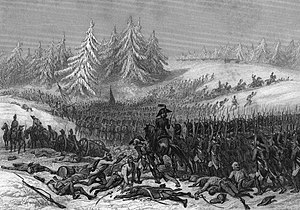Charter War
| This page (or section) is a work in progress by its author(s) and should not be considered final. |
| Charter War | |||||||||
|---|---|---|---|---|---|---|---|---|---|
 | |||||||||
| |||||||||
| Belligerents | |||||||||
|
|
| ||||||||
| Commanders and leaders | |||||||||
|
| |||||||||
The Charter War, sometimes known as the Four Years' War, was a major Novaran conflict fought between a coalition led by Celanora and Lapinumbia against the Cenhelming monarchies of Tretrid and Seccera. Its primary cause is generally agreed to have been the proclamation of the liberal Charter of Privileges in Tretrid, which sparked fears of destabilization caused by the spread of liberalism, though other factors such as continued Celanoran claims on Tretridian territory and the Tretridio-Lapinumbian rivalry contributed to causing the war as well.
Over the course of the war, Tretrid was able to obtain the tactical and operational upper hand but was ultimately unable to capitalize upon it as the war brought it to the brink of bankruptcy. It instead settled for a white peace in the Treaty of Nervino in 1809 but was able to extract reparations from Lapinumbia and Celanora to lessen its own debt burden. As a result, the Charter War has often been described as a partial Tretridian victory, as it was able to achieve all its war goals, limited as they were by strategic constraints.
The war has been credited with mobilizing nationalism as a significant political force in West Novaris. The Charter War also ensured that liberalism stayed firmly rooted in Novaris through Tretrid's and Seccera's constitutions. Both nationalism and liberalism would play a factor in Novaran history throughout the rest of the century.
Background
Republicanism in Tretrid
As the result of a religious schism within Ulvriktru, Tretrid spent much of the later 18th century waging the Ulvriktru Wars of Religion against Norgsveldet. In backing its cause, Tretrid not only used the religious justification of the Ulvriktruar split but also fueled the development and spread of a new ideology, Gothiric Republicanism, which Tretridian intellectuals often synthesized with rationalist ideas appearing in West Novaris. By the end of the Wars of Religion, Jarisven and Ostretheia had become Gothiric Republics. King Bada II also adopted many trappings of Gothiric Republican governance, such as establishing the College of Gothirs to govern matters of religion independently from the crown.
However, the Tretridian monarchy was not immune to criticism. Bada was criticized for his unwritten control over the College of Gothirs, often being lambasted as a 'shadow Fylkir,' supposedly in the name of safeguarding their authority. Some Gothiric republicans even called into question the necessity of the Tretridian monarchy, arguing that the duty to protect the faith was a shared civic duty of the people, and that thus a democratic republic led by rational ideas was the ideal form of government.
By the end of the 18th century, Tretrid had largely run its treasury dry from funding almost thirty years of wars fought overseas, and portions of the Witenagemot were increasingly clamoring for reforms.
Revolution in Seccera
Inspired by republican ideals, in 1801, revolutionaries rose up and took control of most of Celano in Seccera, which was largely administered by Bada's son Ælfræd due to Bada's failing health. Volscine and Tretridian forces quashed the revolution shortly afterwards, but it served as a wake-up call to Ælfræd and his sister Eadgyð, who administered Tretrid in her father's stead.
Bada II died a few months later in 1802, leading to the end of the personal union between Tretrid and Seccera as Eadgyð inherited Tretrid as Eadgyð II while Ælfræd inherited Seccera as Alfredo III.
Constitutionalism and the coalition
The situation in Tretrid and the revolution in Seccera had left the two monarchs with the belief that major reforms needed to be made for either monarchy to have a future. In 1803, Alfredo promulgated a Secceran constitution, largely transforming it into a constitutional monarchy, though he reserved for himself significant political power.
Eadgyð managed to extract some measures from the Witan in order to stabilize the financial situation in Tretrid while she and her close ally Heanric Wilhelmesunu devised a Tretridian constitution. Their efforts came to fruition with the promulgation of the Charter of Privileges in 1804, which codified the rights of the Witan, guaranteeing regular elections, and delegating to it most of the duties of domestic governance. Wilhelmesunu became Prime Minister when the Witan reconvened soon afterwards as the first person to do so after the codification of the office in its modern form.
Both constitutions successfully quieted down republican opposition to the Tretridian and Secceran monarchies and served as a beacon to liberals throughout West Novaris. However, the case of Tretrid in particular proved quite worrying to much of the rest of West Novaris, as it was feared that in adopting a constitution, Tretrid was encouraging revolution and was therefore threatening the aristocratic privilege of most of those in power outside Tretrid and Seccera.
In response, Lapinumbia and Celanora agreed to form an alliance against Tretridian agitation, which soon grew into a coalition. What resulted was a breakdown in diplomatic relations between Tretrid and its neighbors in the coalition, until continued disputes over the status of Cerilezzo led Celanora to declare war on Tretrid in 1805, leading the coalition into war. Seccera declared war on Celanora soon afterwards.